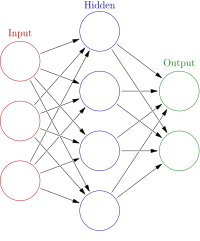
Photo from wikipedia
Abstract The recently introduced complex active optical network (LANER) generalizes the concept of laser system to a collection of links, building a bridge with random-laser physics and quantum-graphs theory. So… Click to show full abstract
Abstract The recently introduced complex active optical network (LANER) generalizes the concept of laser system to a collection of links, building a bridge with random-laser physics and quantum-graphs theory. So far, LANERs have been studied with a linear approach. Here, we develop a nonlinear formalism in the perspective of describing realistic experimental devices. The propagation along active links is treated via suitable rate equations, which require the inclusion of an auxiliary variable: the population inversion. Altogether, the resulting mathematical model can be viewed as an abstract network, its nodes corresponding to the fields along the physical links. The dynamical equations differ from standard network models in that, they are a mixture of differential delay (for the active links) and algebraic equations (for the passive links). The stationary states of a generic setup with a single active medium are thoroughly discussed, showing that the role of the passive components can be combined into a single transfer function that takes into account the corresponding resonances.
Journal Title: Physica D: Nonlinear Phenomena
Year Published: 2020
Link to full text (if available)
Share on Social Media: Sign Up to like & get
recommendations!